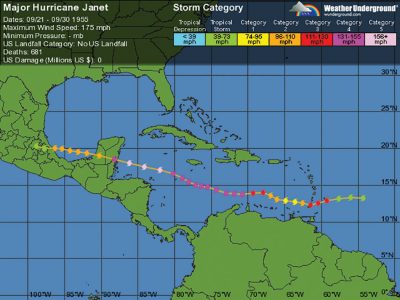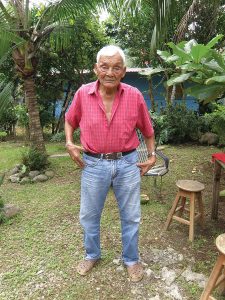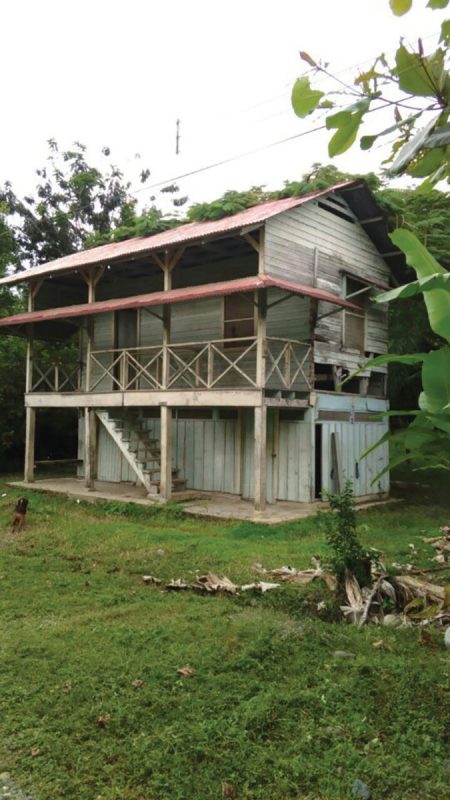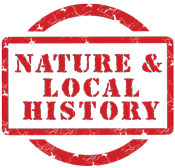Life Before and After Janet
By Jack Ewing
When the paths of powerful storms take them near the Caribbean coast of Costa Rica the accompanying low pressure systems draw in the weather from every direction including across the country and out into the Pacific aOcean. As the clouds move toward the Atlantic storm they are halted by a formidable obstacle, the Talamanca mountain range. As the moisture laden air rises in an effort to clear the mountains it cools, condenses, and falls in torrents on the Pacific side of the country. One recent example, tropical storm Nate caused millions of dollars of damage, 11 deaths, and 11,700 people displaced from their homes. In the 46 years that I have lived on Hacienda Barú, we have on occasion experienced torrential rains caused by Atlantic hurricanes: Joan in 1988, Cesar in 1996, Mitch in 1998, Stan in 2005, Nate in 2017, and many lesser storms.
 But from what I have been able to learn from people who were living on the Pacific coast in 1955 all of these storms were mere thunder showers compared to Hurricane Janet. She slowly made her way across the Caribbean on a course similar to that of Nate with the difference that Janet was a category 4 hurricane, not a tropical storm. Those of you who experienced Nate can only imagine the fury of Janet. On her trek northwards along the coast of central America and into southern Mexico, she became the first category 5 hurricane in the history of the region and the first to cause over 1000 deaths (according to Wikipedia).
But from what I have been able to learn from people who were living on the Pacific coast in 1955 all of these storms were mere thunder showers compared to Hurricane Janet. She slowly made her way across the Caribbean on a course similar to that of Nate with the difference that Janet was a category 4 hurricane, not a tropical storm. Those of you who experienced Nate can only imagine the fury of Janet. On her trek northwards along the coast of central America and into southern Mexico, she became the first category 5 hurricane in the history of the region and the first to cause over 1000 deaths (according to Wikipedia).
There aren’t many people alive today who remember Janet, and none of those who I have interviewed remember her name. The flood is referred to locally as La Llena de 55, or the 1955 flood. Those who lived through it didn’t have access to television, satellite images, early warnings, or internet like we do today. At that time the only way that meteorologists could determine the category of a hurricane was for brave aviators to fly a plane into the eye of the storm and measure the wind speed. One such plane was lost along with its 12 crew members gathering data on Janet. Information about the phenomenon was not readily available to the majority of the people who were ravaged by its fury. All they knew was that torrential rains began to fall and didn’t stop for six days. Alejandro Gutiérrez is one of those who lived through the flood, and he never knew that the name of the lady who brought such devastating change to his life was Janet.
 Born in 1920 in Río Sequito de Santa Cruz, Guanacaste, one of poorest areas in the country, Alejandro quit school at 9 years of age and went to work to help support his mother and siblings. For his hard work he earned a pittance of less than $0.05 a day. Life was very hard in Río Sequito, and opportunity was non-existent. By his late twenties he was earning about $0.35 per day swinging a machete for upwards of 10 hours and with no possibility of escaping his impoverished life situation. That’s why when opportunity called in 1949 he didn’t think twice about leaving everything he had ever known behind and going to work for the United Fruit Company in the banana plantations near Quepos. That opportunity presented itself in the form of a recruiter for the company who came to Río Sequito offering work. Alejandro didn’t hesitate a second. “Put me on that list”, he said. “I’m going to work in Quepos and earn some decent money”.
Born in 1920 in Río Sequito de Santa Cruz, Guanacaste, one of poorest areas in the country, Alejandro quit school at 9 years of age and went to work to help support his mother and siblings. For his hard work he earned a pittance of less than $0.05 a day. Life was very hard in Río Sequito, and opportunity was non-existent. By his late twenties he was earning about $0.35 per day swinging a machete for upwards of 10 hours and with no possibility of escaping his impoverished life situation. That’s why when opportunity called in 1949 he didn’t think twice about leaving everything he had ever known behind and going to work for the United Fruit Company in the banana plantations near Quepos. That opportunity presented itself in the form of a recruiter for the company who came to Río Sequito offering work. Alejandro didn’t hesitate a second. “Put me on that list”, he said. “I’m going to work in Quepos and earn some decent money”.
On departure day Alejandro took all of his earthly belongings, a blanket, a few items of clothing, and, of course, his machete. He didn’t own a pair of shoes. He and a few other young men walked 40 kilometers to a small port called Barco Quebrado where they boarded a boat called “Rio Grande”, owned by the banana company. Behind in Río Sequito remained his mother, several brothers and sisters, and three illegitimate daughters. Even though Alejandro had only the equivalent of $0.27 in his pocket he was no stranger to hard work and was full of self-confidence. Quepos and the United Fruit Company were his new life.
He never looked back.
The first job that was assigned to Alejandro was clearing overgrown lots for planting of experimental crops. There had been problems with fungal diseases in the bananas and the company was looking for possible alternatives, like cacao and oil palm. He was paid by the hectare rather than by the hour. This was a big advantage for a hard worker like Alejandro. He and a friend set out to clear one hectare (2.7 acres) per day, and they accomplished their goal every single working day. They were paid $6.44 for each hectare, $3.22 for each man, more than nine times what he was making in Río Sequito. For the first time in his life Alejandro had spending money in his pocket.
 Later the company moved Alejandro to Damas to work planting cacao. There he met the love of his life, Dominga Gómez. When they began living together in common law marriage, the company provided them with a house. The traditional United Fruit Company village consisted of up to 20 two-story houses built around a soccer field. The houses had a fire box called a fogón for cooking on the first floor and sleeping quarters on the second floor. The couple lived in this type of house for the next six years. Their first daughter was born at a farm called Finca Pastora. Over the following years they lived at farms called Finca Negro, Finca Mona, Finca Rey, and Finca Marítima all of which produced bananas. Two more daughters were born while Alejandro and Dominga lived at Finca Rey”.
Later the company moved Alejandro to Damas to work planting cacao. There he met the love of his life, Dominga Gómez. When they began living together in common law marriage, the company provided them with a house. The traditional United Fruit Company village consisted of up to 20 two-story houses built around a soccer field. The houses had a fire box called a fogón for cooking on the first floor and sleeping quarters on the second floor. The couple lived in this type of house for the next six years. Their first daughter was born at a farm called Finca Pastora. Over the following years they lived at farms called Finca Negro, Finca Mona, Finca Rey, and Finca Marítima all of which produced bananas. Two more daughters were born while Alejandro and Dominga lived at Finca Rey”.
In late Setpember of 1955 Alejandro and his family were living at Finca Marítima located a little more than one kilometer from the Savegre River. One day rains like no one had ever seen before began to pour out of the sky, and it didn’t take long to realize that serious flooding was on the way. The soccer field became a lake, and the water soon rose to the level of the first floor of the dwellings. Alejandro moved the fogón to the second story of the house along with all of their food and other essential items. The waters rose for five days reaching to within half a meter of the second floor before the rains abated and the flood waters began to recede. Everyone was safe and sound. The house was still standing and the family had managed to save most of their possessions.
The company didn’t fare so well. The banana plantations were totally destroyed as was the railroad that had once transported bananas from Portalon to Quepos. The railroad bridge over the Savegre River was gone. The banana company decided not to replant bananas, and in early 1956 hundreds of workers, including Alejandro, were dismissed. He had left Río Sequito seven years earlier and assumed that he would be with the company for many years to come, and suddenly his life was turned upside down. All because of a hurricane called Janet.
Alejandro thought about his situation and realized that things weren’t as bad as they first seemed. He was much better off than he was seven years earlier when he left Río Sequito. He had a loving wife and three wonderful daughters; he was in excellent health, still young enough for hard work, and he had some savings.
A friend offered to sell Alejandro a farm near Matapalo. The farm had a thatch roofed house with a dirt floor, two milk cows, and a horse. There was some pasture, but most of the farm was in secondary and primary forest. For a little over $800 he bought the 23 hectare (58 acre) farm with the cows and the horse with saddle and bridle included. Everything they owned fit into the back of a small pickup that Alejandro hired to move them to Matapalo. Everything was unloaded at the edge of the road, and a neighbor with oxen and a cart hauled it the rest of the way to their new home. Alejandro worked hard, felled trees, cleared brush, and planted pasture and crops. He built a house where Dominga gave birth to four more girls and two boys. All of their nine children were born at home.
Dominga passed away in 1979. Alejandro kept the farm for 13 more years before selling it in 1992 at 72 years of age. He bought a large lot near Matapalo and built houses for himself and several of his daughters. As of this writing Don Alejandro is 98 years old, 62 of which he has lived in Matapalo. He has 12 children, 26 grandchildren, 30 great grandchildren, and 5 great great grandchildren. Still as spry as ever, is hearing is excellent, he can see just fine without eye glasses, and takes only one pill a day, for blood pressure. He attributes his health and longevity to clean living and hard work. “I’m not a religious man”, Don Alejandro told me, “but I talk with God every night. I never ask for anything, but thank him for my health, my good life, and my family.”


